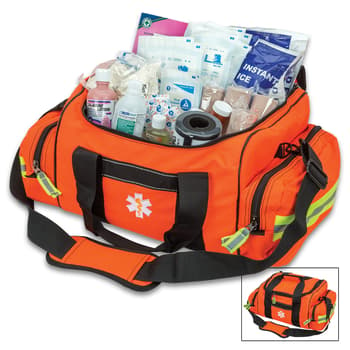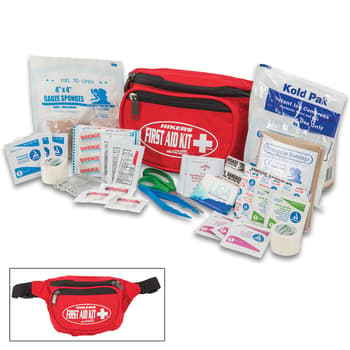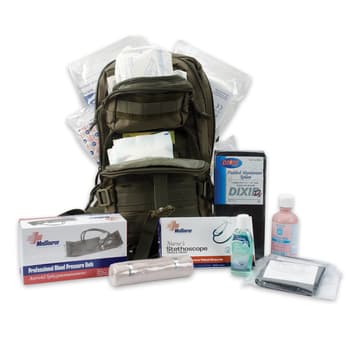An underestimated cause of a medical emergency is weather extremes. Simply, when a body becomes too hot or too cold, it will start to shut-down, and subsequently die. Unfortunately, folks seem to keep overlooking this fact and these weather-related emergencies and deaths continue to occur. Since Winter is upon us, I want to focus on cold weather medical emergencies.
Hypothermia
I’m going to start with the most severe, which is hypothermia. It occurs when the temperature of the body falls so low that the organs cannot function. It can happen quickly and can be hastened by exhaustion and dehydration. Hypothermia can occur if the temperature drops to 40°F and is combined with wind and rain. Damp clothing will lose 80% of its insulation capability. There are a number of situations where it can happen: camping, hiking, boating, being stranded in your vehicle and working outside.
Signs of Hypothermia
Being able to identify the signs that an individual is suffering from hypothermia falls under life or death knowledge. I can’t stress how important it is to know the signs if you and your family member, friend or co-worker are going to be out in freezing temperatures for an extended period of time. The first sign to look for, of course, is excessive shivering. The next indicators are slurred speech, a glassy stare and impaired judgement. A person will also feel numbness or weakness and breathing may become shallow and the pulse may be weak. The victim will experience drowsiness and then lose consciousness. It’s crucial that you identify the initial signs of hypothermia before an individual gets to the loss of consciousness stage.
First Aid For Hypothermia
Temperature related first aid is basically, either warming the body up or cooling it down and the primary goal is to restore the body temperature to normal. Because hypothermia is no joke, the first thing you need to do is call 911. If you’re out somewhere remote camping or hiking, you need to get the victim to a hospital as soon as possible. In the meantime, however, you can start by making sure that the individual is inside where it’s warm or, if out in a remote area, sheltered from wind and insulated from the cold ground. If clothes are wet, they need to be immediately replaced with something dry like a blanket whether you’re inside or outside. A wool blanket is one of the best options and you should definitely have one at home, in your vehicle and in your camping gear. Another great tool is a survival blanket, which is windproof, waterproof and will reflect up to 90 percent of your body heat back to you.
Warm the victim slowly, starting with the trunk and abdomen, not the hands and feet. The key is to get the victim’s inner core temperature up first. However, do not warm the body too quickly by immersing it in hot or warm water. Hot water bottles and chemical hot packs can be used after being wrapped in a towel or washcloth before applying. They need to be strategically placed under the arm pits, the back of the neck, the wrists and between the thighs, which will transfer heat to major arteries. If you’re out in the wild, you can use warm rocks to do the same, making sure they’re not too hot. Putting an individual close to a camp fire serves only to warm them on the outside and may cause cold blood to circulate to the core and bring its temperature down. If possible, give the victim warm liquids about every 15 to 20 minutes. Never try to force liquid down an unconscious person’s throat. Monitor breathing in case CPR becomes necessary. These are only first aid measures. The most important thing is that the patient gets professional medical attention as soon as possible.
Frostbite
Frostbite is when the skin and underlying tissues actually freeze. The most susceptible body parts are the fingers, toes, nose and earlobes. There are actually three stages of this process. Frostnip occurs first and then, if untreated, progresses to superficial frostbite and deep frostbite. It occurs because exposed skin in cold and windy weather is very vulnerable but, when the temperature is low enough, even covered skin can be affected. In windchill of -16°F, frostbite will happen to exposed skin in less than 30 minutes. It can also be caused by direct skin contact with ice, super cold liquids and freezing metals. One of the problems with frostbite is that you may not notice it until it’s too late or someone else points it out to you. So, it’s important that you recognize the signs and be vigilant.
Signs of Frostnip
A mild, form of frostbite, you won’t suffer permanent skin damage with frostnip. You’ll experience extreme coldness of the skin and a prickling feeling. As the affected skin warms up, there’s going to be pain and tingling. If exposure to the cold is continued, numbness will occur.
Signs of Superficial Frostbite
With the numbness, the progression into superficial frostbite will show-up with minor changes in the affected skin’s color and it may begin to feel warm, which is a serious sign that you’re progressing into deep frostbite. As you rewarm the skin, it will look mottled and there will be stinging, burning and swelling. Also, at this stage, fluid-filled blisters can pop-up 12 to 36 hours after rewarming the affected area.
Signs of Deep Frostbite
With deep frostbite, all layers of the skin and tissues below it are seriously affected. It looks waxy and turns blue-grey or white. There will be no sensation of cold, pain or discomfort. Basically, you lose all feeling in the affected area. After rewarming, large blisters pop-up in 24 to 48 hours and the tissue turns black and hardens as it dies.
First Aid For Frostbite
If an individual suffers from just frostnip, it can be effectively treated by rewarming the skin in the area that’s affected. All other frostbite needs professional medical care because the skin and tissue can be permanently damaged without it. The first thing to do, obviously, is to get the person out of the cold as soon as possible and protect the frostbitten area from further exposure to cold. You can’t allow the area to refreeze, which could be a danger if you’re out camping or hiking and can’t immediately get to a hospital. Warm the injury by soaking it in warm water (100°-105°) until it appears red and warm. Then, loosely bandage the area with dry, sterile dressings. It’s important that you handle the area gently, never rubbing or chafing it, and if the person’s finger or toes are frostbitten, place dry, sterile gauze between them to keep them separated. If any blisters start appearing, make sure that you don’t break them. Give the individual a pain reliever to assist in reducing the pain of the injury. Once again, if you identify the signs of frostnip, this treatment should be sufficient. However, if there’s increased pain, swelling, inflammation or the person starts running a fever, seek medical attention. If you’ve identified the signs of frostbite, then, after performing the above first aid, get them to a hospital as soon as possible.
An Ounce of Prevention…
The best defense against hypothermia and frostbite is prevention. Most of the time, these maladies can be avoided through diligently monitoring the weather and climate conditions, especially, the windchill. Remember, in windchill of -16°, it can take less than 30 minutes for exposed skin to become frostbitten and, if the temperature drops to 40°F with wind and rain, hypothermia can occur. So, if you don’t have to be out in extreme cold weather conditions, don’t! However, if you are going to be out, make sure that you’re dressed appropriately for the specific conditions. If it’s rainy, cold weather gear absolutely needs to be waterproof, as well as, insulated. Wearing a hat that covers the ears and gloves like the
M48 Balaclava Facemask And Gloves Set is important to keep frostbite susceptible areas protected. Dress in layers because air trapped between the layers will also provide insulation. That’s why wool clothing is so effective at retaining insulation. The individual wool fibers will actually hold air. Your undergarments should wick moisture away from the skin and, most importantly, your socks should, too. Also, before you go outside, make sure you’re hydrated, which means no alcohol. Alcoholic beverages will cause your body to lose heat. When you’re outside, stay active to keep your blood flowing to help maintain body heat. Finally, take frequent breaks from the cold and, generally, limit your time outside.




